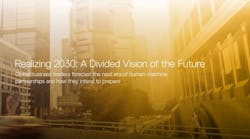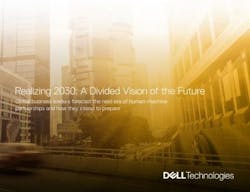Realizing 2030: A Divided Vision of the Future
Dell Technologies recently released new research that examines the future of human-machine partnerships and reveals that business leaders are divided regarding the future.
For the research report, Realizing 2030: A Divided Vision of the Future, nearly 4,000 business leaders across 17 countries were surveyed. Results showed mixed forecasts on the changing relationship between humans and emerging technologies by 2030, as well as business leaders’ recommendations for transformation today.
We chatted with Jason Shepherd, IoT CTO with Dell Technologies, to get an insider’s perspective. Take a look…
Smart Industry: What survey result did you find most surprising regarding the changing relationship between workers and technologies?
Jason: I was surprised by how evenly split the responses were, which translates to a good degree of skepticism about the positive impact of digital on businesses. Meanwhile we see time and time again markets being disrupted by companies with innovative digital business models. Also surprising is the percentage of organizations that are skeptical about their own ability to become a successful digital business in 2030. If you examine the numbers, only 27% of businesses think they are leading in digital transformation, 42% don’t believe they can compete over the next decade and a majority (57%) of businesses are struggling to keep-up with the pace of change. These are due to a variety of factors, such as lack of digital vision and strategy, lack of workforce readiness, technology constraints, time and money and more. Our goal is to help customers determine the most impactful solutions and services that they can implement to reduce costs, improve efficiency and scale effectively, but most importantly transform their business.
Smart Industry: What steps are business leaders taking to ensure the smooth integration of workforce and machines?
Jason: Despite the importance of key underlying technology trends like IoT, AI, robotics, AR/VR and blockchain, digital transformation ironically often starts with addressing people and their inherent resistance to change. In fact, 38% of respondents cited their inability to transform their workforce culture and mindset as the main reason they’re unsure whether their organization will be able to compete over the next decade. Some of the top tips identified were gaining employee buy-in about digital vision, aligning compensation, training and KPIs to digital goals and strategy, tasking senior leaders with spearheading digital change, and making the customer experience a boardroom concern.
The Dell Digital Transformation Index and the Digital Transformation Benchmark were developed so companies could find out how they compare to their peers and competitors. By seeing where they land on the Benchmark, businesses can pinpoint their strengths, where they’re lacking and what they need to do to future-proof their organization.
Jason: The survey found that 50% of business leaders forecast that automated systems will free up time. If we’re able to spend less time on admin and other time-consuming tasks, that gives us more time to innovate, which will ultimately impact business. Despite the unknown, it’s inspiring to think about these new possibilities. In fact, a workshop hosted by the Institute for the Future (IFTF) in 2017 concluded that around 85% of the jobs that today’s learners will be doing in 2030 haven’t been invented yet. This was further reflected in a survey question that 56% of respondents agreed that in order to prepare for jobs that haven’t been created yet, schools will focus on teaching how to learn rather than what to learn.
As noted earlier, the majority of businesses are struggling to keep-up with the pace of change. I’m worried that some organizations won’t take the right steps toward executing on a digital-transformation strategy before it’s too late. Beyond providing solutions and services that are cost-effective, seamless, and simple to implement and utilize, we strive to inspire our customers to innovate and take risks so they can continue to grow and stay competitive in their respective markets.
Smart Industry: Did you see differences in attitudes per geographic region? What does this tell you?
Jason: The study didn’t explicitly seek to uncover regional differences, but we saw consistent responses from business leaders across the world that they have a general understanding of what’s happening and the need to invest, despite being faced with barriers to get to the next stage in the transformation process. Outside of the study, at Dell we definitely see different attitudes about digital transformation across regions, most notably between developed and emerging countries. For example, a utility-provider in a developed country might be focused on squeezing the last bit of efficiency out of their power grid, whereas a utility in a developing region might be more concerned about simply providing reliable power. That said, we’re also seeing the pace of innovation accelerate in emerging countries as the underlying technologies become more accessible.
One area in which the study picked up significant differences in attitudes was generational, with 87% of respondents saying their organization will struggle to offer equal opportunities to different generations of workers. When asked what is being done to mitigate generational differences, top responses included providing training for all members of staff, equipping employees with the latest personal-technology solutions and tools, all while encouraging peer-learning across generations. This further reiterates the importance of people in the digital-transformation journey.
Smart Industry: How have these survey results colored your vision of 2030?
Jason: The results make it clear that the journey to 2030 will be very exciting, but organizations need help. We want to support our customers in any fashion needed and in many cases the engagement will be about people and relationships, rather than technology. These results give us insight into where the market stands and what the needs are, so we can continue to educate, develop new solutions and services and work with our partners and customers to make sure they are getting the answers they need to compete in a constantly evolving world. These findings serve as a great foundation because the more we know the more we can help.




